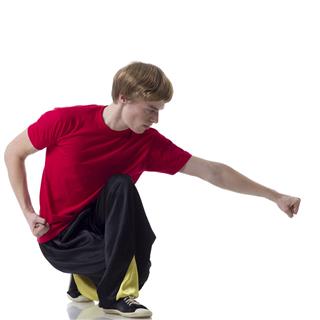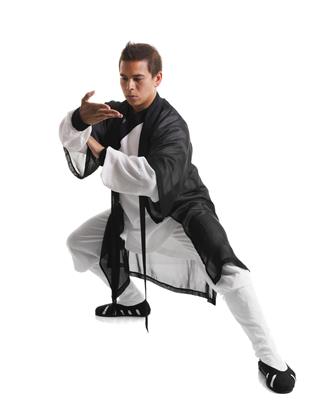
Kung fu is an ancient Chinese combat technique, popularized in the West by several Hollywood action movies. Although the term ‘kung fu’ has become popular in the West, the correct term for Chinese martial arts is ‘wushu’.
The origins of Chinese martial arts, erroneously known in the West as Kung Fu are said to lie three thousand years ago in ancient China, where personal combat was considered to be a form of science. It was only in the 5th-6th century BC — during the rule of the Han Dynasty — that definite records of combat strategies and techniques (empty-handed and weapon-oriented) were printed.
The next major contribution in the history of the Chinese martial arts can be attributed to the establishment of the Shaolin temple and contributions made by the Ch’an (Chinese equivalent of Zen) Buddhism.
Kung fu is not only a physical exercise, but also a spiritual one, owing to its teaching of the manipulation of chi, the life force.
Wushu By Any Other Name
The term ‘kung fu’ is an erroneous moniker given to Chinese martial arts. The actual Chinese term for ‘martial arts’ is Wushu. ‘Kung fu’ simply means ‘an achievement attained through hard work’, and can be used to describe achievements completely unrelated to martial arts. The term ‘wushu’, on the other hand, comes from the word wu, meaning ‘military’ and shu, meaning ‘skill’ or ‘discipline’.
Kung Fu Styles
Northern Shaolin
Many aspects of Shaolin Kung Fu spread throughout China, undergoing many adaptations and revisions. The present system, however, specializes in long-range fighting rather than grappling. It is an aggressive style, believing that attack is the best form of defense. It emphasizes on kicking, leaping and whirling blocks based on wide, open stances.
The Northern kung fu style was created by Gu Yu-jeung. Yu-jeung traveled the Northern parts of China to study the various styles taught in the region, and assimilated them into a unified kung fu style, Northern Shaolin.
Despite the name, the Northern Shaolin style differs from the southern Shaolin school of kung fu, which emphasizes on punches, open-hand strikes etc.
Dragon
The dragon is revered in the Chinese culture as a powerful but benevolent creature worthy of worship. The dragon was closely associated with male fertility. Thus, the kung fu style based on the dragon is considered to be one of the most powerful styles, both physically and spiritually.
The dragon style encompasses a combination of hard as well as soft techniques (blocking an attack or deflecting/evading an attack). Its specialty is the floating and the sinking movements with the shoulders lowered and the elbows bent. As a result of this, powerful thrusting power can be released. The dragon style focuses on powerful, quick, short-range attacks, rather than sweeping, long-range motions. This style focuses on forearms as a primary offensive and defensive instrument; this is a specialty only observed in the dragon style. Like most southern kung fu styles, the dragon style focuses on the upper body, avoiding kicks and jumps in favor of punches and open-palm striking techniques.
White Crane
This is considered to be the most beautiful of all the kung fu styles. The four main principles of the white crane are:
To Hurt, to Evade, to Penetrate, to Intercept.
This fighting style concentrates on close-quarter combat, although it also teaches numerous long-range techniques. It imitates various avian self-defense techniques, such as pecking (achieved through fingertips), or flapping the wings, supported by strong, deep-rooted stances. The crane style focuses on evading the most powerful attacks and then quickly attacking the exposed weak areas of the foe. Since it doesn’t require as much strength as other kung fu styles and requires flexibility and agility, the crane style is popular as a self-defense technique for women.
Wing Chun
The Wing Chun is a relatively modern school of kung fu, having evolved in the 18th century.
The essence of this style is that when the opponent attacks, the blow should be absorbed and neutralized. This is reflected in the description of the ideal stance for wing chun wushu: strong but elastic, rooted but with give.
Wing chun masters generally attack along the imaginary vertical line in the center of the human body, since many weak spots lie on or around this line. Wing chun emphasizes the importance of a contracted stance, not allowing an obvious entry for the opponent to exploit.
Hung Gar
Hung Gar stresses on close-quarter fighting methods. Very unlike the far-ranging, jumping fighting styles, this system is very effective during combat in confined paths and alleys, i.e., primarily self-defense. This style is sometimes misinterpreted and criticized for being too reliant on the strength of the body rather than the cultivation of chi.
Praying Mantis
This style is adapted from the aggressive behavior of a predatory insect called the praying mantis. It is superficially similar to the white crane style of kung fu. The mantis style includes deflecting the opponent’s attacks, and then quickly and incessantly attacking the opponent’s weak spots.
This style is characterized by the unique use of the ‘mantis hook hand posture’ — the elbow makes an obtuse angle (c. 120°), the hand makes a similar angle with the forearm (the arm and the hand are almost parallel), and all digits except the forefinger are rolled inwards, with the thumb supporting the forefinger. This mimics the arm of a praying mantis. The ‘hook’ of the forefinger can be used to attack weak spots such as the eyes, nose etc.
The Monkey Style
The monkey style of kung fu style may look comical, but it is one of the deadliest disciplines of wushu. It imitates the movements of apes, including their facial expressions.
A practitioner of the monkey style of kung fu has to be highly acrobatic, and is trained in various acrobatic movements that are quite difficult for humans, but can be performed quite easily by apes. The combat training consists of mostly open-handed strikes to crucial areas, such as groin, eyes or throat.
Drunken Boxing
Drunken boxing, or zui quan, is considered as the most difficult kung fu fighting style to master, due to its highly acrobatic and fluid nature. It imitates a drunkard’s movement to lull the opponent into a false sense of security, before springing a surprise with deadly accuracy. It consists of various staggering and falling techniques, which can be used to deceive an opponent.
It received media attention after the release of Jackie Chan’s 1978 film The Drunken Master.
Choy Lee Fut
Choy lee (or li) fut is an amalgam of diverse kung fu fighting styles, including the Northern styles, which focus on circular, sweeping attacks and elaborate footwork, and the Southern styles, which value hand attacks over kicks. It also encompasses both long-range and grappling techniques. Choy li fut is considered the best method for self-defense as it teaches most techniques and attacks. It has been advocated by none other than the legendary martial artist Bruce Lee.
These are a few of kung fu fighting styles that have survived the torrents of time. An extensive study of the technique can be achieved by learning from a master, and can prove vitally useful in not just self-defense but also, spiritual progress.









































